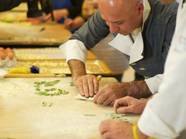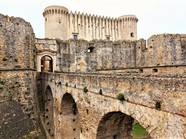On 11/4, responding to Anthony Tamburri's i-Italy article "An Italian/American State of Mind", I wrote: "It seems that five generations later, the immigrant peasant mentality of learning a trade or getting good paying factory job is still the norm."
A member responding off line wrote: "Dr. Francis Feminella's (SUNY Albany) statistics suggest there has been a huge leap forward in the last generation by IAs in the matter of college education; in fact, larger than any other group. Graduate school may be another matter."
The purpose of this note is to continue this important discussion.
Dr. Feminella's conclusions are consistent with similar statistics posted on the very excellent John D. Calandra website also indicating an increase in numbers of Italian Americans going to college. However, recall what specifically we are talking about: Anthony Tamburri's very provocative phrase "Italian/American STATE OF MIND." (emphasis added) 'States of mind' cannot be inferred from a single set of quantitative values. More youths of all ethnicities are going to college these days. The colleges are full. Student loans outstanding are currently 35 billion dollars. From the single fact that more Italian American youths are going to college, little can be inferred about their 'state of mind'. [In Aristotelian parlance: a conclusion cannot be deduced from a minor premise (i.e. fact) in the absence of a major premise (i.e. theory).]
'State of mind' implies psychological motivations and sociological conditions contributing to those motivations. For example, in 1960 there was no community college in the Rochester N.Y. area and only a few small colleges offering a limited number of majors. Few of the very many Italian American high school graduates went to college. However, industry was booming (Kodak, Xerox, General Motors, etc). A large majority of those graduates found very good paying jobs that would support suburban middle class family life styles. Today, there are no such jobs. Buildings Kodak constructed in the 1960's are now being sold or torn down. However, today the area colleges are building incessantly. There is now a very large community college and large universities offering a great variety of majors. The student population has increased by magnitudes.
Thus, a reasonable hypothesis to explain the increased numbers of college students generally and Italian American students particularly would be that there are no jobs so the next best thing is to go to school in the hopes that more education will lead to a job. Note: getting the job is the 'suggested' motivation. Not the "state of mind" 'love of letters' ( i.e. literature, philosophy, history, etc.).
In an effort to find supporting evidence for this hypothesis one could look at the curriculums offered and their enrollment numbers. For example, the community college offers very popular majors in auto mechanics, heating & air conditioning, drafting, construction, food service, physical therapy, etc. Similarly, vocational majors can be found at colleges offering bachelor and graduate degrees.
In short, when one wants to learn a trade these days, they don't go down to a union hall, they go to college. Thus, statistics indicating more Italian Americans are going to college do not necessarily imply that there has been a change in Italian American "state of mind" regarding education. Rather, they may suggest a sociological change in how one learns a trade and gets a job (the immigrant peasant virtue).
Again, as I wrote before, to understand the "Italian American state of mind" necessitates a major social scientific study. Our artists have intimated it to us: e.g. Don DeLillo's "Underground" and Tina De Rosa's "Paper Fish". Social-anthropolgocial works have delved into it: e.g. Whyte's "Street Corner Society" and Gans' "The Urban Villagers". However, it seems to me that the Italian American state of mind that Professor Tamburi refers to is still an enigma - ironically to Italian Americans themselves.































